Your soap may fail to reach trace due to insufficient mixing technique, expired lye, incorrect water-to-oil ratio, improper temperature control, high olive oil content, false trace occurrence, or inadequate emulsification. Using a stick blender instead of hand-stirring, testing lye potency, balancing water amounts, maintaining temperatures around 80°F, adjusting oil formulations, and recognizing true vs. false trace can solve these issues. These troubleshooting tips will transform your failed batches into successful, well-emulsified soap.
7 Ways Your Soap Failed To Reach Trace
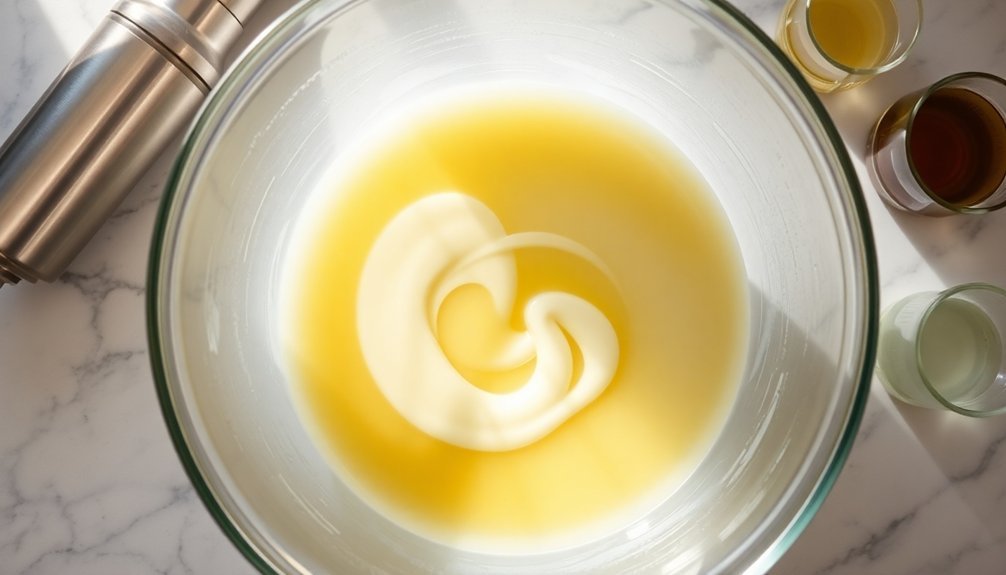
When making handmade soap, reaching proper trace—that thick, pudding-like consistency—indicates successful saponification has begun.
If your soap batter refuses to thicken, you're likely facing one of several common issues. Insufficient mixing time is a primary culprit; hand stirring rarely provides enough agitation, so invest in a stick blender for efficient emulsification.
Your measurements might be off—double-check your lye and water amounts with a soap calculator to verify proper ratios.
Old or improperly stored lye absorbs moisture and becomes ineffective, stalling saponification. Too much water dilutes your mixture, especially with hard oils.
Timing matters with additives too—some fragrance oils accelerate trace while others slow it down. Test small batches to understand how each ingredient affects your soap's journey to that perfect trace consistency.
Insufficient Mixing Technique: Hand-Stirring vs. Stick Blender
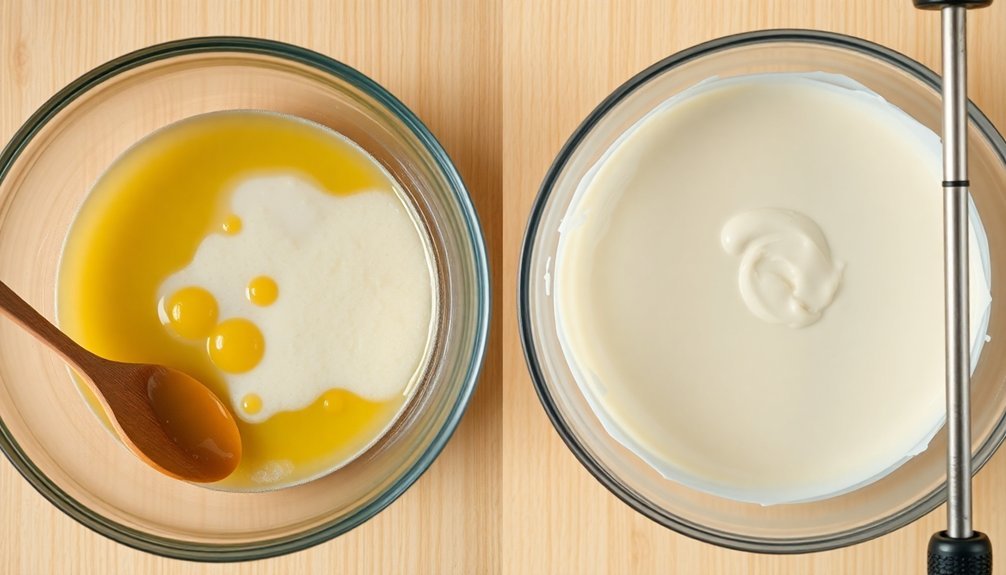
Although patience might be a virtue in many aspects of soapmaking, it won't compensate for insufficient mixing power when attempting to reach trace. Hand-stirring can demand several hours of consistent motion, while a stick blender reduces this to mere minutes, dramatically improving efficiency.
Your mixing technique directly impacts the saponification process. Stick blenders create uniform emulsification, whereas hand-stirring often leaves unblended oil pockets. When your soap batter fails to thicken, insufficient mixing is typically the culprit.
If you choose a stick blender, alternate between short bursts and hand-stirring to avoid accelerating trace too quickly.
For hand-stirring enthusiasts, maintain vigorous, consistent motion throughout. Remember, regardless of your chosen method, thorough mixing is non-negotiable—without it, your soap may never reach proper trace and result in separation.
Expired or Weak Lye: Testing for Potency Issues
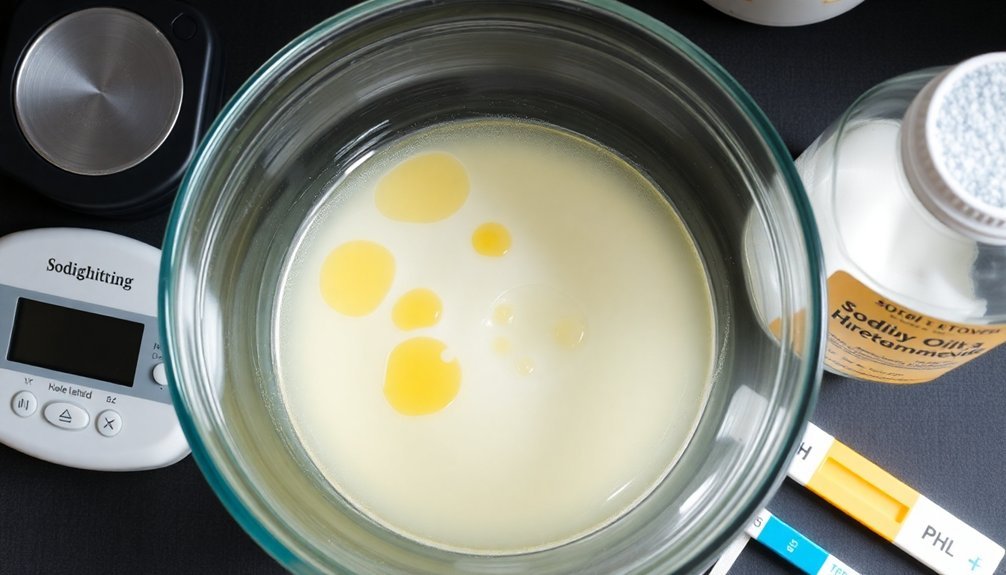
Even the most vigorous mixing technique can't compensate for expired lye. When sodium hydroxide absorbs moisture from the air, it loses potency, directly affecting the saponification process and preventing your soap from reaching trace.
| Lye Condition | Observable Signs | Action Required |
|---|---|---|
| Fresh | Strong heat reaction | Proceed with recipe |
| Weakening | Mild heat reaction | Use slightly more lye |
| Expired | No heat reaction | Replace immediately |
| Clumped | Visible caking | Discard and buy new |
| Uncertain | Weak trace formation | Conduct a test batch |
To verify potency, dissolve a small amount in water—fresh lye will generate significant heat. Always store your lye in an airtight container in a cool, dry place to maximize its 2-3 year shelf life. Before committing to large batches, run a small test to avoid wasting valuable ingredients on weak lye.
Incorrect Water-to-Oil Ratio: Finding the Right Balance
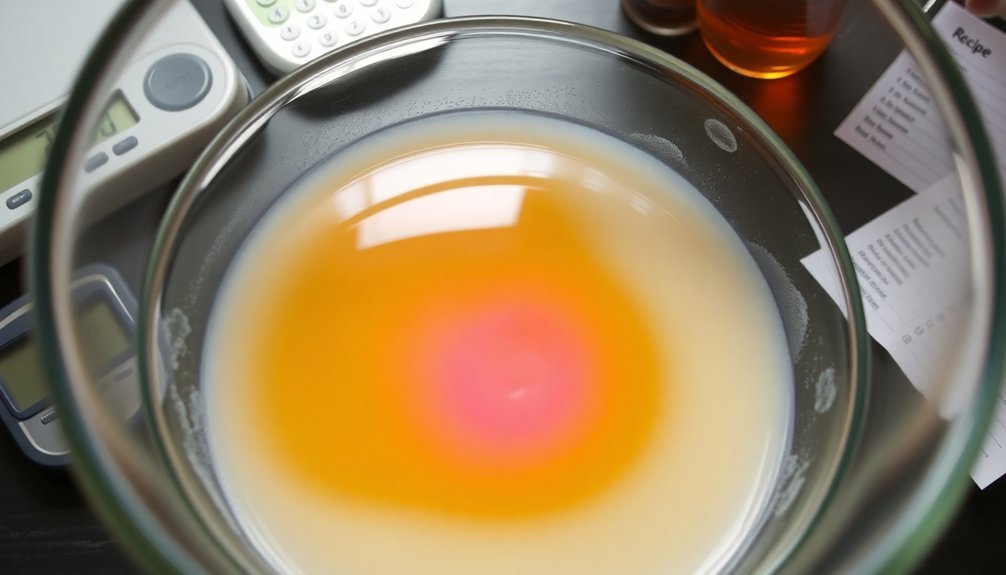
Finding the perfect water-to-oil ratio stands as one of the most critical factors in successful soap making, yet many crafters overlook its importance.
When your lye solution contains excessive water, it can dilute the mixture and prevent proper emulsification, leaving you frustrated as your batch refuses to reach trace.
For high-oleic oils, consider implementing a water discount of 10-15% to achieve faster, more effective trace.
If you're working with hard oils, balance your water content carefully to guarantee the mixture doesn't become too thin to emulsify properly.
For 100% olive oil soap, aim for approximately 5 oz of water per 100g of lye to create ideal trace conditions.
Your best approach is to use a soap calculator that accounts for your specific oil properties, removing guesswork and helping you achieve consistent results.
Temperature Problems: Too Cold or Too Hot
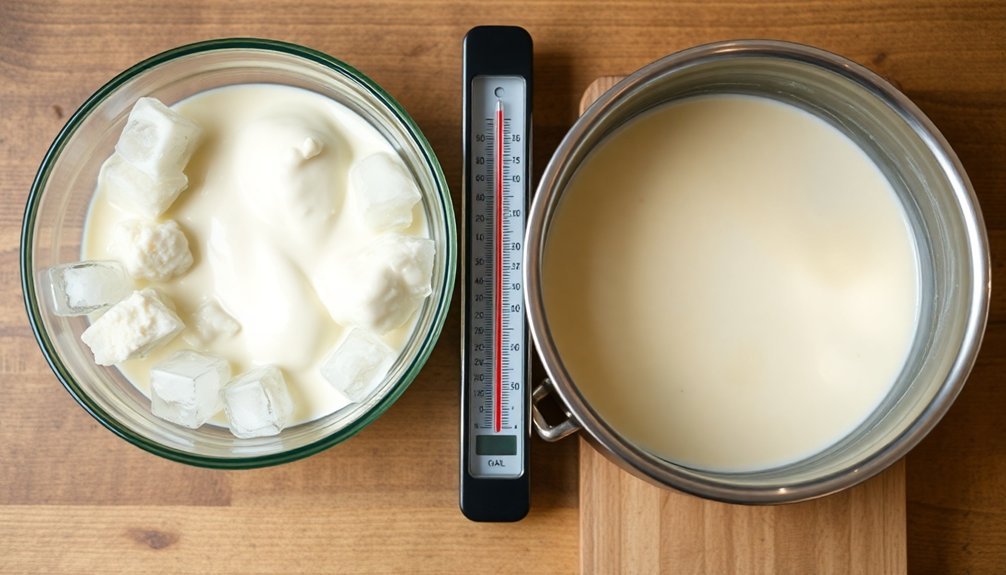
When your soap batch refuses to reach trace, temperature issues often lurk behind the failure. Your soap-making success depends on maintaining proper temperatures throughout the process, as both extremes can derail your efforts.
- If your oils are too cold (below room temperature), they won't properly emulsify with the lye solution, delaying or preventing trace.
- Too hot oils accelerate trace dramatically, giving you little working time with your soap batter.
- False trace occurs at higher temperatures when the mixture appears thick but hasn't truly saponified.
- Solid oils must be fully liquefied—any remaining solids will interfere with emulsification.
- Your lye solution temperature matters—excessively hot lye causes rapid thickening, while cold lye slows the chemical reaction.
Consistently monitoring temperatures of both oils and lye is essential for achieving perfect trace.
High Olive Oil Content: Adjusting for Slow-Tracing Oils
Temperature issues aren't the only culprit when your soap refuses to reach trace. High olive oil content in recipes can greatly delay the process due to its low saponification value and more liquid consistency. When working with slow-tracing oils like olive, you'll need to make strategic adjustments.
First, consider reformulating your recipe to include faster-tracing oils like coconut oil or palm oil to balance the blend. While mixing, maintain higher temperatures to accelerate the chemical reaction.
Use your stick blender in short, controlled bursts to effectively emulsify without overworking the mixture.
Another effective technique is implementing a water discount—reducing the water in your lye solution can help your soap reach trace more quickly.
These adjustments will help you successfully work with olive oil while avoiding the frustration of a mix that refuses to thicken.
False Trace: Recognizing Premature Solidification
When your soap mixture thickens quickly but isn't truly emulsified, you're experiencing false trace—a common issue where solid oils harden prematurely rather than properly saponify.
Your temperature management is essential here, as cooler hard oils will solidify before they can fully react with the lye solution, creating only the illusion of trace.
If you suspect false trace has occurred, you can still salvage your batch through rebatching, which involves gently reheating the mixture to allow proper emulsification to complete.
Solid vs. Emulsified
Many soapmakers mistakenly believe they've achieved trace when their soap mixture thickens, only to discover later that what they've encountered is actually false trace. Understanding the difference between solid and emulsified soap is vital for successful soapmaking.
- False trace occurs when solid oils cool and solidify before proper emulsification with the lye solution.
- A thick consistency resembling pudding doesn't always indicate true trace—it may just be premature solidification.
- When you pour this mixture into molds, separation often occurs because the oils weren't fully integrated.
- Monitoring temperature is essential—keep both oils and lye solution warm enough to maintain proper emulsification.
- If you suspect false trace, let the mixture rest briefly, then re-blend with your stick blender until you achieve true trace.
Temperature Makes Difference
Although experienced soapmakers understand its importance, the role of temperature in achieving true trace cannot be overstated. When your oils and lye solution aren't at ideal temperatures, you're likely to encounter false trace—a deceptive thickness that isn't true emulsification but premature solidification.
| Temperature Issue | Result | Solution |
|---|---|---|
| Oils too cold (below 27°C) | Solid oils harden, creating false trace | Warm oils to 27-30°C |
| Lye solution too cool | Curdled appearance, incomplete saponification | Maintain lye at similar temperature to oils |
| Inconsistent temperatures | Unpredictable trace development | Use thermometer to monitor both components |
You'll save yourself frustration by keeping both components around 27°C (80°F) during soap-making. A reliable thermometer is your best friend in preventing temperature-related trace issues—don't skip this critical step in your process.
Rebatch When Necessary
Despite your best efforts, you'll occasionally encounter false trace—a soap-making phenomenon where your mixture appears to reach trace but hasn't properly emulsified.
When your soap mixture resembles thick pudding but lacks proper saponification, don't panic—rebatching can save your creation.
- Monitor temperature throughout the process to prevent oils from solidifying prematurely
- Extend mixing time with a stick blender to guarantee thorough emulsification
- If you suspect false trace, let the mixture sit briefly and observe texture changes
- Rebatch by gently heating the soap in a crockpot or double boiler until it emulsifies
- Continue mixing until you achieve true trace—a pudding-like consistency that holds its shape
Recognizing the difference between false and true trace will save you time and ingredients while guaranteeing your soap cures properly.
Frequently Asked Questions
Why Is My Soap Not Reaching a Trace?
Your soap isn't reaching trace because you're likely using insufficient mixing time, weak lye, excess water, or improper oil ratios. You'll need to adjust your technique, ingredients, or temperature to achieve proper emulsification.
What Causes False Trace in Soap Making?
Your soap shows false trace when solid oils cool and solidify before saponifying. You'll notice it when you've mixed insufficiently, used inconsistent temperatures, or haven't balanced hard and soft oils properly in your recipe.
How to Know When Soap Has Reached Trace?
You'll know soap has reached trace when your batter thickens to leave a pattern on the surface. It'll progress from light (creamy) to medium (like pudding) to thick (holds shape) as saponification continues.
What Does a False Trace Look Like in Soap?
A false trace looks deceptively thick and creamy but isn't truly emulsified. You'll notice oils pooling on the surface or separating from the mixture. It won't maintain thickness after 20-30 seconds of rest.
In Summary
Now you're equipped to tackle trace problems in your soap making journey. Remember that patience is key—some formulations simply take longer to reach trace than others. Don't get discouraged by setbacks; they're valuable learning opportunities. By adjusting your technique, ingredients, and equipment based on these troubleshooting tips, you'll soon be creating beautiful, successful batches consistently.

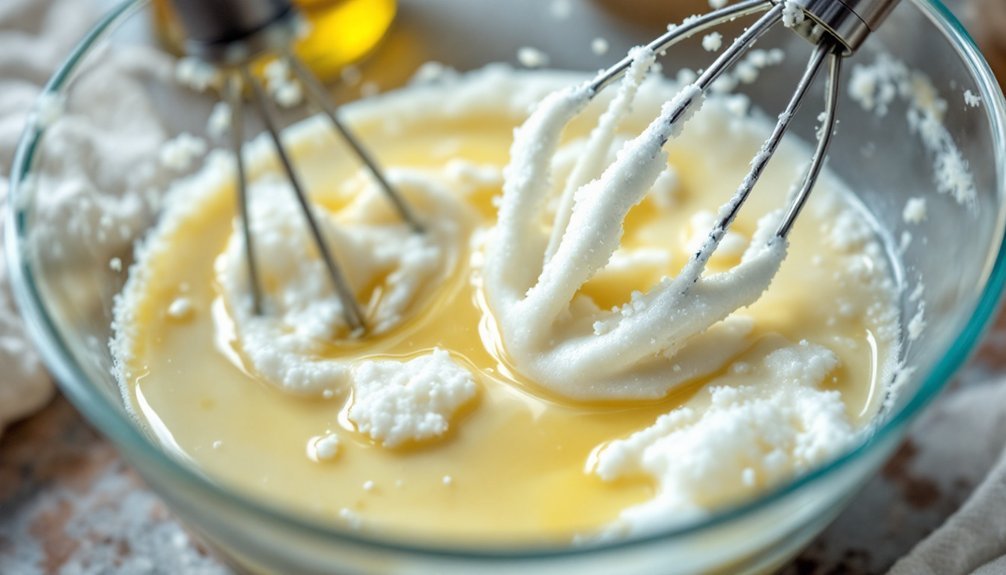



Leave a Reply